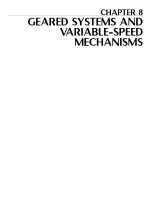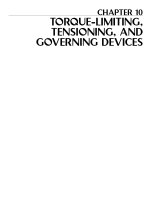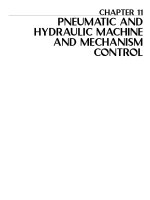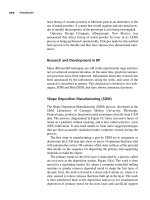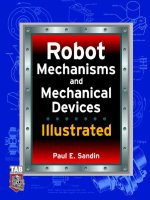Robot Mechanisms and Mechanical Devices Illustrateds on bone fracture repair - identifying important cellular characteristics ppt
Bạn đang xem bản rút gọn của tài liệu. Xem và tải ngay bản đầy đủ của tài liệu tại đây (4.67 MB, 179 trang )
Mechanical and mechanobiological influences
on bone fracture repair
- identifying important cellular characteristics
A catalogue record is available from the Eindhoven University of Technology Library
ISBN 978-90-386-1146-4
Copyright © 2007 by H. Isaksson
All rights reserved. No part of this book may be reproduced, stored in a database or retrieval
system, or published, in any form or in any way, electronically, mechanically, by print,
photoprint, microfilm or any other means without prior written permission of the author.
Cover design: Jorrit van Rijt, Oranje Vormgevers
Printed by Universiteitsdrukkerij TU Eindhoven, Eindhoven, The Netherlands.
Financial support from the AO Foundation, Switzerland is gratefully acknowledged.
AO Foundation
Research
Mechanical and mechanobiological influences
on bone fracture repair
- identifying important cellular characteristics
PROEFSCHRIFT
ter verkrijging van de graad van doctor
aan de Technische Universiteit Eindhoven,
op gezag van de Rector Magnificus, prof.dr.ir. C.J. van Duijn,
voor een commissie aangewezen door het College
voor Promoties in het openbaar te verdedigen op
maandag 26 november 2007 om 16.00 uur
door
Hanna Elisabet Isaksson
geboren te Linköping, Zweden
Dit proefschrift is goedgekeurd door de promotoren:
prof.dr.ir. H.W.J. Huiskes
en
prof.dr.ir. K. Ito
Copromotor:
dr. C.C. van Donkelaar
To my family and friends for all their
support through these years
vii
Contents
Contents vii
Summary ix
List of original publications xi
1 Introduction 1
2 Bone fracture healing and computational modeling of bone mechanobiology 7
3 Comparison of biophysical stimuli for mechano-regulation of tissue differentiation
during fracture healing 27
4 Corroboration of mechano-regulatory algorithms: Comparison with in vivo results 41
5 Bone regeneration during distraction osteogenesis: Mechano-regulation by shear
strain and fluid velocity 55
6 A mechano-regulatory bone-healing model based on cell phenotype specific activity71
7 Determining the most important cellular characteristics for fracture healing, using
design of experiments methods 91
8 Remodeling of fracture callus in mice can be explained by mechanical loading 107
9 Discussion and conclusions 123
Appendix A: Theoretical development of finite element formulation for modeling
cellular activity………… 135
Appendix B: Taguchi orthogonal arrays and design of experiments methods 141
References 147
Samenvatting 163
Acknowledgement 165
Curriculum Vitae 167
ix
Mechanical and mechanobiological
influences on bone fracture repair
- identifying important cellular characteristics
Summary
Fracture repair is a complex and multifactorial process, which involves a well-programmed
series of cellular and molecular events that result in a combination of intramembranous and
endochondral bone formation. The vast majority of fractures is treated successfully. They heal
through ‘secondary healing’, a sequence of tissue differentiation processes, from initial
haematoma, to connective tissues, and via cartilage to bone. However, the process can fail and
this results in delayed healing or non-union, which occur in 5-10% of all cases. A better
understanding of this process would enable the development of more accurate and rational
strategies for fracture treatment and accelerating healing. Impaired healing has been associated
with a variety of factors, related to the biological and mechanical environments. The local
mechanical environment can induce fracture healing or alter its biological pathway by
directing the cell and tissue differentiation pathways. The mechanical environment is usually
described by global mechanical factors, such as gap size and interfragmentary movement. The
relationship between global mechanical factors and the local stresses and strains that influence
cell differentiation can be calculated using computational models.
In this thesis, mechano-regulation algorithms are used to predict the influence of mechanical
stimuli on tissue differentiation during bone healing. These models used can assist in
unraveling the basic principles of cell and tissue differentiation, optimization of implant
design, and investigation of treatments for non-union and other pathologies. However, this can
only be accomplished after the models have been suitably validated. The aim of this thesis is
to corroborate mechanoregulatory models, by comparing existing models with well
characterized experimental data, identify shortcomings and develop new computational
models of bone healing. The underlying hypothesis throughout this work is that the cells act as
sensors of mechanical stimuli during bone healing. This directs their differentiation
accordingly. Moreover, the cells respond to mechanical loading by proliferation,
differentiation or apoptosis, as well as by synthesis or removal of extracellular matrix.
In the first part of this work, both well-established and new potential mechano-regulation
algorithms were implemented into the same computational model and their capacities to
predict the general tissue distributions in normal fracture healing under cyclic axial load were
compared. Several algorithms, based on different biophysical stimuli, were equally well able
to predict normal fracture healing processes (Chapter 3). To corroborate the algorithms, they
were compared with extensive in vivo experimental bone healing data. Healing under two
distinctly different mechanical conditions was compared: axial compression or torsional
rotation. None of the established algorithms properly predicted the spatial and temporal tissue
distributions observed experimentally, for both loading modes and time points. Specific
Summary
x
inadequacies with each model were identified. One algorithm, based on deviatoric strain and
fluid flow, predicted the experimental results the best (Chapter 4). This algorithm was then
employed in further studies of bone regeneration. By including volumetric growth of
individual tissue types, it was shown to correctly predict experimentally observed spatial and
temporal tissue distributions during distraction osteogenesis, as well as known perturbations
due to changes in distraction rate and frequency (Chapter 5).
In the second part of this work, a novel ‘mechanistic model’ of cellular activity in bone
healing was developed, in which the limitations of previous models were addressed. The
formulation included mechanical modulation of cell phenotype and skeletal tissue-type
specific activities and rates. This model was shown to correctly predict the normal fracture
healing processes, as well as delayed and non-union due to excessive loading, and also the
effects of some specific biological perturbations and pathological situations. For example,
alterations due to periosteal stripping or impaired cartilage remodeling (endochondral
ossification) compared well with experimental observations (Chapter 6). The model requires
extensive parametric data as input, which was gathered, as far as possible, from literature.
Since many of the parameter magnitudes are not well established, a factorial analysis was
conducted using ‘design of experiments’ methods and Taguchi orthogonal arrays. A few
cellular parameters were thereby identified as key factors in the process of bone healing.
These were related to bone formation, and cartilage production and degradation, which
corresponded to those processes that have been suggested to be crucial biological steps in
bone healing. Bone healing was found to be sensitive to parameters related to fibrous tissue
and cartilage formation. These parameters had optimum values, indicating that some amounts
of soft tissue production are beneficial, but too little or too much may be detrimental to the
healing process (Chapter 7).
The final part of this work focused on the remodeling phase of bone healing. Long bone post-
fracture remodeling in mice femora was characterized, including a new phenomenon
described as ‘dual cortex formation’. The effect of mechanical loading modes on fracture-
callus remodeling was evaluated using a bone remodeling algorithm, and it was shown that the
distinct remodeling behavior observed in mice, compared to larger mammals, could be
explained by a difference in major mechanical loading mode (Chapter 8).
In summary, this work has further established the potential of mechanobiological
computational models in developing our knowledge of cell and tissue differentiation processes
during bone healing in general, and fracture healing and distraction osteogenesis in particular.
The studies presented in this thesis have led to the development of more mechanistic models
of cell and tissue differentiation and validation approaches have been described. These models
can further assist in screening for potential treatment protocols of pathophysiological bone
healing.
xi
List of original publications
The work presented in this thesis was carried out at the AO Research Institute in Davos,
Switzerland, and within the Bone- and Orthopaedic Biomechanics section of the department of
Biomedical Engineering at Eindhoven University of Technology. It resulted in the following
peer-reviewed publications and manuscripts, referred to by their roman numerals. The thesis
also contains unpublished data.
I Comparison of biophysical stimuli for mechano-regulation of tissue
differentiation during fracture healing.
H. Isaksson, W. Wilson, C.C. van Donkelaar, R. Huiskes, K. Ito
Journal of Biomechanics, 39(8):1363-1562, 2006
II Corroboration of mechanoregulatory algorithms for tissue differentiation
during fracture healing: Comparison with in vivo results
H. Isaksson, C.C. van Donkelaar, R. Huiskes, K. Ito
Journal of Orthopaedic Research, 24(5):898-907, 2006
III Bone regeneration during distraction osteogenesis:
Mechano-regulation by shear strain and fluid velocity
H. Isaksson, O. Comas, J. Mediavilla, W. Wilson,
C.C. van Donkelaar, R. Huiskes, K. Ito
Journal of Biomechanics, 40(9):2002-2011, 2007
IV A mechano-regulatory bone-healing model based on cell phenotype
specific activity
H. Isaksson, C.C. van Donkelaar, R. Huiskes, K. Ito
Manuscript submitted for publication
V Determining the most important cellular parameters for the characteristics
of proper fracture healing, using design of experiments methods
H. Isaksson, C.C. van Donkelaar, R. Huiskes, J. Yao, K. Ito
Manuscript submitted for publication
VI Remodeling of fracture callus in mice can be explained by mechanical loading
H. Isaksson, I. Gröngröft, W. Wilson, B. van Rietbergen, A. Tami,
C.C. van Donkelaar, R. Huiskes, K. Ito
Manuscript submitted for publication
xii
1
1 Introduction
This chapter includes a short introduction to the problems
concerning bone tissue regeneration, particularly with regard to
fracture healing. The role of the mechanical environment, both
globally and locally, is then introduced with a focus on how
computational models can be of assistance. The overall hypothesis
and an outline of the specific goals of the thesis are then described,
including the specific research questions investigated in each of the
constituent studies. The general methodology is briefly outlined.
1
1
Chapter 1
2
1.1 Problem
Bone healing is so common in life that it is easy to overlook how astonishing it is as a
biomechanical phenomenon. In contrast to other adult tissues, which heal with the production
of scar tissue, bone heals with bone. New bone is formed and continuously remodeled until the
original site of injury can hardly be recognized. During fracture repair, bone is formed by a
combination of processes, which are closely related to both embryonic development and adult
growth (Marks and Hermey, 1996).
Despite their natural healing capacity and the extensive amount of research conducted in this
area, delayed healing and non-union of bones are frequently encountered. For example in the
United States 5-10 % of the over 6 million fractures occurring annually develop into delayed
or non-unions (Praemer et al., 1992; 1999; Einhorn, 1995; 1998b). Bone fractures cost society
large amounts of money every year in primary treatment, follow-up operations due to delayed
or non-unions, and the cost of lost employment. Furthermore, ageing of the population is
expected to increase the prevalence of fractures due to osteoporosis. In the European Union, in
the year 2000, the number of osteoporotic related fractures was estimated at 3.8 million,
resulting in direct costs for osteoporotic fractures to the health care services of € 32 billion
(Reginster and Burlet, 2006). It has been predicted that 40% of all postmenopausal women
will suffer one or more fractures during their remaining lifetimes (Compston et al., 1998;
Reginster and Burlet, 2006). Hence, prevention and effective treatment of such complications
are desirable.
It is well recognized that mechanical stimulation can induce fracture healing or alter its
biological pathway (Rand et al., 1981; Brighton, 1984; Wu et al., 1984; Goodship and
Kenwright, 1985; Aro et al., 1991; Claes et al., 1997; Rubin et al., 2001). New bone formation
is also related to the direction and magnitude of loading, affecting the internal stress state in
the repairing tissue (Park et al., 1998; Augat et al., 2003; Bishop et al., 2006). However, the
mechanisms by which mechanical stimuli are transferred, via cellular mediators, into a
biological response remain unknown.
Mechanobiology describes the mechanisms by which biological processes are regulated by
signals to cells that are induced by mechanical loads (Roux, 1881; van der Meulen and
Huiskes, 2002). When the mechanisms of mechanically-regulated tissue formation are
understood and well defined at the cellular level, physiological conditions and
pharmacological agents may be developed and used to prevent non-unions and, furthermore,
to help accelerate fracture repair and restore optimal function. Computer modeling is having a
profound effect on scientific research (Sacks et al., 1989). Many biological processes,
including bone healing, are so complex that physical experimentation is either too time
consuming, too expensive, or impossible. As a result, mathematical models that simulate these
complex systems are more extensively used. In mechanobiology, these computational models
have been developed and used together with in vivo and in vitro experiments to quantitatively
determine the rules that govern the effects of mechanical loading on cells and tissue
differentiation, growth, and adaptation and maintenance of bone. Mechanical perturbations are
Introduction
3
applied to a model geometry, and the local mechanical environment is calculated, using the
finite element method. The biological aspects of the computations are based on different
premises for local mechanical variables stimulating certain cellular activities, for example cell
proliferation, or changes in bone structure. Computational models are gradually becoming
more sophisticated with increasing computational power and mechanobiological knowledge.
Both experimental and computational studies are critical to advance our knowledge in
mechanobiology. Integration of the fields is important, since models can help interpret
experiments and experiments can provide relationships and observations for model
development.
Using these principles, mechano-regulation algorithms were proposed to investigate the
influence of mechanical stimuli on tissue differentiation. These algorithms were extensively
applied to study bone healing (Chapter 2.8). They have used strain invariants and fluid
hydrostatic pressure or fluid velocity in different combinations as biofeedback variables.
These algorithms need to be validated against direct in vivo data, before further developments
can follow. Validation could help both the understanding of basic biology during bone
regeneration and in developing clinical treatment protocols for fracture healing. Additionally,
validated models can be useful in designing new experiments, and theoretical models and
animal experiments together can lead to new research questions and advances in
mechanobiology. However, to date validation attempts have not been carried out sufficiently.
This is partly due to the need for experimentally reliable and repeatable outcomes, and
controlled mechanical environments. These are rarely available, because the required
conditions are very difficult to meet in an experimental setting. Moreover, many experiments
that are used for validation are originally carried out with other scientific questions in mind.
The principles of bone healing are very similar to other bone forming processes. Bone healing
has great similarities to bone formation and growth during fetal development (Marks and
Hermey, 1996; Ferguson et al., 1999). Furthermore, it appears that the understanding of
principles in fracture repair may have implications beyond fracture treatment, with
applications in tissue regeneration in general, such as during distraction osteogenesis,
osseointegration of implants, and in tissue engineering. Therefore, a better understanding of all
the factors that influence the bone healing process in general, and mechanobiology in
particular, will have important applications in skeletal generation and regeneration.
1.2 Aims and outline of the thesis
The previous section identified the need for further research on mechanoregulatory
mechanisms of bone healing. The general objective of this work is to enhance the knowledge
of the role of mechanical factors in tissue differentiation during bone regeneration in general,
and fracture healing in particular, by corroborating mechanoregulatory algorithms. The
fundamental hypothesis in these studies is that the local level of mechanical stimulation, using
stress and strain invariants, determines the cell and tissue differentiation pathways. The cells
act as sensors, and they respond depending on their environment. Mechanical stimulation
influences where either fibrous tissue, cartilage or bone tissue forms by directing the
Chapter 1
4
differentiation of mesenchymal cells into fibroblasts, chondrocytes or osteoblasts. This thesis
develops methods for corroboration of computational models with direct in vivo experimental
data. The general objectives are divided into specific aims and hypotheses, which are
addressed in subsequent chapters. The specific objectives with each chapter are specified
below:
Chapter 2 – Literature review
• To provide a comprehensive literature basis to describe the current knowledge and
previous research conducted in the area of bone healing and computational
mechanobiology.
Chapter 3 – Comparing existing models
• To implement and compare several existing mechano-regulation algorithms with
regards to their abilities to predict the normal fracture healing processes.
• To investigate whether individual parameters such as strain invariants, i.e. deviatoric
strain or volumetric deformation, i.e. pore pressure and fluid velocity can be used to
predict tissue differentiation during normal fracture healing.
Chapter 4 – Determining validation status and identify inadequacies
• To corroborate the mechano-regulatory algorithms with extensive in vivo bone healing
data from animal experiments, including interfragmentary conditions, different from
those for which they were developed.
• To reveal which of these algorithms reflect the actual mechanobiological processes the
best, by analyzing the corroborations at time points representing early and late healing.
Chapter 5 – Implementing volumetric growth
• To investigate whether mechano-regulation by octahedral shear strain and fluid
velocity, the algorithm selected in Chapter 4, can predict the spatial and temporal
tissue distributions observed during experimental distraction osteogenesis.
• To study variations in predicted tissue distributions due to alterations in distraction rate
and frequency.
Chapter 6 – Developing a mechanistic cell model
• To develop a new model of tissue differentiation based on cell activity, including
matrix and cell phenotype-specific descriptions of migration, proliferation,
differentiation, apoptosis, matrix production and degradation, in order to overcome
discrepancies identified in Chapter 4.
• To determine the importance of including cell-specific activities when modeling tissue
differentiation and bone healing.
Chapter 7 – Establishing the relative importance of cellular characteristics
• To determine the importance of each parameter in the mechanistic cell model, by
employing ‘design of experiments’ methods and Taguchi orthogonal arrays.
Introduction
5
Chapter 8 – Characterizing post fracture remodeling in mice
• To experimentally describe the remodeling phase of fracture healing in mice.
• To investigate the hypothesis that the differences during the remodeling phase of
fracture healing observed in mice compared to larger mammals and humans, can be
explained by a main difference in mechanical loading mode.
Chapter 9 – Discussion
•
To summarize the results and conclusions and discuss the logic of the thesis as a whole
and to incorporate it with past research and future prospects.
1.3 General approach
Two- and three dimensional finite element models were developed as adaptive models for
tissue differentiation. Poroelastic finite element formulations were used to calculate the
biophysical stimuli and mass- or heat transfer finite element formulations were employed for
the calculations of cellular activities. Adapted tissue types (matrix production) regulated the
mechanical properties and could also alter the geometry of the tissue. Results from in vivo
animal experiments were employed for a range of qualitative and quantitative comparisons
between computational predictions and experimental data.
Verification was ensured by assessing the ability of the model to solve the mathematical
representations correctly and by performing convergence studies. Validation was performed
by assessing the models ability to represent the mechanical and biological behavior of specific
experimental outcomes (Figure 1-1). The software that was used to create the computational
models and the origin of the experimental data employed, is described below.
Figure 1-1: General scheme of the approach for validation of computational models. The
research within this thesis focused on the left hand side, and the experiments required (right
hand side) were adopted from other studies that were performed at the AO Research Institute.
Chapter 1
6
The numerical models developed in this thesis were implemented and solved with the
following software: The overall framework of the tissue differentiation model was
implemented and solved in Matlab (v 5.3-7.1 Mathworks). Depending on complexity, the
finite element meshes where created using either Marc Mentat (MSC Software), ABAQUS
CAE (v 6.3-6.5 Simulia, Dassault Systemés) or Matlab. All finite element models were solved
using ABAQUS (v 6.3-6.5 Simulia, Dassault Systemés). Parts of the codes were written in
external programs in FORTRAN 77 or C++. The remeshing algorithm (Chapter 5), was
modified based on existing code from Dr Jesus Mediavilla (2005). The biphasic swelling
model adapted to implement volumetric growth in Chapter 5 originated from Dr Wouter
Wilson (2005). The bone remodeling algorithm used in Chapter 8 was adopted from the theory
by Dr Ronald Ruimerman (2005). The mechanistic model in Chapter 6 and 7 was solved using
a special finite element formulation, developed for biological modeling of cell activity during
this work. The details are provided in Appendix A.
For validation purpose, results from several animal experiments, originally carried out to
answer other research questions were used (Figure 1-1, right side). The availability of
experimental results, such as radiographs, histology, histomorphometry, mechanical testing,
reaction force measurements and micro computed tomography were vital for the work
presented in this thesis. It allowed both quantitative and qualitative comparisons between
computational predictions and experimental results, a strategy which is a necessity for
validations of theoretical models. The in vivo ovine tibia fracture model employed in Chapter
4 was provided by Dr Nicholas Bishop, as part of his PhD studies (Bishop, 2007). The
experimental ovine distraction model used in Chapter 5 is from Dr. Ulrich Brunner’s MD
habilitation research (Brunner, 1992). The murine experimental fracture healing data, which is
part of Chapter 8, was conducted by Dr. Ina Gröngröft, DVM, as part of her dissertation
(Gröngröft, 2007).
7
2 Bone fracture healing and
computational modeling of
bone mechanobiology
This chapter provides a literature review of the topics addressed in
this thesis. It includes a brief description of bone morphology, the
mechanisms by which it is generated, regulated and repaired, and
the role that the cells play in these processes. This is followed by an
overview of skeletal disorders, in particular bone fractures and the
healing process, including different forms of healing, and possible
complications. Thereafter, the influence of mechanics on bone
healing and the current understanding of mechanobiology are
summarized. Finally, previous studies in the area of computational
mechano-regulation of tissue differentiation are reviewed and
theories and algorithms described.
2
2
Chapter 2
8
2.1 Bone and bone fracture
The adult human skeleton consists of 206 bones. They act as a support framework for the body
and protect the internal organs. Together with the muscles and joints, they facilitate movement
and participate in maintenance of the body’s mineral balance (Marks and Hermey, 1996).
2.1.1 Bone structure and composition
Morphologically, bones are classified as cortical or trabecular (cancellous) bone. Cortical bone
forms the outer shell of every bone. It is compact, stiff and strong and has a high resistance to
all loads: bending, axial and torsion, which are especially important in the shafts of long bones
(Buckwalter et al., 1996a). In contrast, trabecular bone is a less dense, less stiff, open pore
matrix, which acts as a mechanically efficient structure in supporting the thinner cortical shells
at the ends of long bones and in the vertebrae (Buckwalter et al., 1996a). The shafts of the
long bones are referred to as the diaphyses, and the expanded ends as the epiphyses. The ends
of the epiphyses are coated with articular cartilage and other bone surfaces are covered by a
well vascularized soft-tissue layer, known as the periosteum. The periosteum isolates and
protects the bone from surrounding tissues and provides cells for bone growth and repair.
Similarly, the inner surfaces of the long bones are lined by the endosteum. Bone marrow is the
soft tissue that fills the medullary cavity of the long bones and the spaces between the
trabeculae. It serves as storage for precursor cells, which are involved in repair.
Bone tissue can also be woven or lamellar. Woven bone is laid down rapidly and has
randomly oriented collagen fibers, and low strength. In adults it is observed mainly at sites of
repair, at tendon or ligament attachments and in pathological conditions. In contrast, the
collagen fibers in lamellar bone are aligned and are much stronger. Woven bone is mostly
replaced by lamellar bone during growth or repair (Buckwalter et al., 1996b).
Bone consists mainly of extracellular matrix (ECM), divided into organic and inorganic
components. The organic components consist primarily of type I collagen (Rossert and
Crombrugghe, 1996), and the inorganic component consists primarily of hydroxyapatite and
calcium carbonates (Marks and Hermey, 1996). The combination of organic fibers enclosed in
an inorganic matrix provides a stiff and strong composite structure, in which the mineral
component resists compression and the collagen fibers resist tension and shear (van der and
Garrone, 1991; Marks and Hermey, 1996). The remainder of the skeleton consists of cells and
blood vessels. There are four different cell types in human bones: osteoblasts, osteoclasts,
bone lining cells, and osteocytes. Osteoblasts are bone forming cells. They line the surfaces of
the bones and produce osteoid (Buckwalter et al., 1996a). Osteocytes are osteoblasts that
became surrounded by bone matrix growing around them, forming a cavity, or “lacunae”.
They remain active in the maintenance of bone and are believed to regulate bone remodeling
(Buckwalter et al., 1996b). Bone-lining cells, also called pre-osteoblasts, are found in the
periosteal and endosteal surfaces. Osteoclasts are multinucleated cells whose function is bone
resorption. They break down bone and release the minerals into the blood (Buckwalter et al.,
1996b). Osteoblasts, osteocytes and bone-lining cells differentiate from mesenchymal stem
cells, and osteoclasts from hemopoietic stem cells (Owen, 1970).
Bone fracture healing and computational modeling of bone mechanobiology
9
2.1.2 Bone formation and growth
Bone forms, grows and resorbs continuously, by remodeling processes. The formation of bone
occurs by two methods, intramembranous and endochondral ossification. These are discussed
in greater depth in the following chapters, since both are prominent during bone healing.
Briefly, intramembranous ossification occurs during formation of the ‘flat’ bones, for those in
the skull, for example (Buckwalter et al., 1996b). It forms directly from basic mesenchymal
tissue, by differentiation from pre-osteoblasts into osteoblasts, which lay down osteoid.
Intramembranous bone formation occurs as appositional growth on bone surfaces, thereby
increasing their width (Buckwalter et al., 1996b). Endochondral ossification occurs in long
bone formation and growth. The bone develops from a cartilage template, which calcifies
along a front and is replaced by bone as blood-capillaries tunnel through, providing bone
forming cells (Buckwalter et al., 1996b).
About 5% of the skeleton is undergoing remodeling, or renewal, at any time. Haversian
remodeling is a process of resorption followed by replacement of bone, with little change in
shape, and occurs throughout life (Marks and Hermey, 1996). A cluster of osteoclasts drill a
tunnel into the bone, creating a cone. Behind the tip, osteoblasts fill up the cone with new
bone with living cells, connected to the capillaries within the canal (Buckwalter et al., 1996b)
(Figure 2-1). Remodeling releases calcium and repairs micro damage. It is also responsible for
bone adaptation to the mechanical environment (Wolf, 1892), resulting in bone thickening in
regions of increased stress and bone thinning in regions of decreased stress.
Figure 2-1: Schematic diagram of haverisan remodeling (Reprinted from Rüedi et al. (2007),
Copyright by AO Publishing, Davos, Switzerland)
2.1.3 Bone fracture
Bone fractures when its strain limit is exceeded. A fracture disrupts the blood supply and
causes damage to the surrounding tissues, resulting in hemorrhage, anoxia, cell death and
aseptic inflammation (Simmons, 1985). Most fractures are caused by physical trauma. The
risk of fracture can increase when medical conditions, such as osteoporosis or cancer, weaken
the bones.
Bone fractures are classified by their appearance and the extent of damage to the surrounding
tissues (Rüedi et al., 2007). All fractures investigated in this thesis were simple transverse
fractures. Particular treatment strategies are used for each fracture type, including external
fixation, nailing and plating which are employed in Chapters 4, 5 and 8.
Chapter 2
10
2.2 Fracture healing
Fracture results in a series of tissue responses that remove tissue debris, re-establish the
vascular supply, and produce new skeletal matrix (Simmons, 1985). Unlike the healing
processes of other tissues, which produce scar tissue, bone has the ability to repair itself. Once
a fracture has healed and undergone remodeling, the structure will have returned to the pre-
injury state. There are two main types of fracture healing: Primary and secondary.
2.2.1 Primary healing
Primary fracture healing, also known as direct healing, involves intramembranous bone
formation and direct cortical remodeling without any external tissue (callus) formation (Rahn
et al., 1971; Perren, 1979). Primary healing only occurs when there is a combination of
anatomical reduction, small displacements of the bony ends, and either a small gap or direct
contact of the fractured cortical bone ends (Rüedi et al., 2007). Osteons traveling along the
length of the bone are able to cross the fracture site and bridge the gap, laying down cylinders
of bone (Figure 2-2). Gradually the fracture is healed by the formation of numerous osteons. It
is generally a slow process that can take months to years until healing is complete.
Figure 2-2: Primary healing. New osteons connecting the bone fragments across a fracture
line (Reprinted from Rüedi et al. (2007), Copyright by AO Publishing, Davos, Switzerland)
2.2.2 Secondary healing
In contrast to primary healing, secondary healing occurs in the presence of some
interfragmentary movement and is the process by which fractures heal naturally. It involves a
sequence of tissue differentiation processes by which the bone fragments are first stabilized by
an external callus (Rahn, 1987; Perren and Claes, 2000). Recovery of bone strength is
generally more rapid than in primary healing.
Stages of repair during secondary fracture healing
The process of bone repair by secondary healing can be divided into three overlapping stages
– the inflammatory, reparative and remodeling phases. Healing begins with inflammation
which is followed by the formation of soft and hard callus during the reparative phase. Finally
the callus is resorbed by remodeling (Cruess and Dumont, 1985; Frost, 1989). This thesis
Bone fracture healing and computational modeling of bone mechanobiology
11
focuses on the reparative (Chapter 3-7) and remodeling (Chapter 8) phases of fracture healing.
The relative duration of these phases is shown in Figure 2-3.
Figure 2-3: Phases of fracture healing and their relative length. The figure has been
recreated based on Cruess and Dumont, (1975).
a) b) c)
Figure 2-4: Schematic drawing of the three main stages of fracture repair. a) Inflammatory
phase, b) reparative phase and c) remodeling phase. The figure has been adapted from Cruess
and Dumont, (1975).
Inflammation
The inflammatory phase begins simultaneously with the occurrence of the fracture (Figure
2-4a). During the trauma, blood vessels, the periosteum and the surrounding soft tissues are
ruptured and a haematoma (blood cloth) forms. The haematoma serves as an important source
of haematopoeitic cells and platelets that initiate the inflammatory response (Buckwalter et al.,
1996b). Large numbers of signaling molecules, including cytokines and growth factors, are
released (Bolander, 1992). The disruption of the blood supply also causes bone necrosis at the
edges of the fracture ends. Many of the cytokines released have angiogenic functions to
restore the blood supply. Also, pluripotent mesenchymal stem cells invade the haematoma at
this time. Cell division is first observed along the periosteum, and within a few days the
activity is increased along the entire area next to the fracture, where it remains high for weeks
(McKibbin, 1978).
Chapter 2
12
Mesenchymal cells, originating from the periosteum, endosteum, bone marrow, and possibly
the vasculature of the muscle-tissue surrounding the haematoma (Postacchini et al., 1995;
Iwaki et al., 1997; Gerstenfeld et al., 2003b), migrate towards the fracture region. No cells
originate from the actual fracture gap. The mesenchymal cells and the inflammatory cells form
a loose granulation tissue. Mesenchymal cells proliferate, to later differentiate down specific
pathways to become fibroblasts, chondrocytes, or osteoblasts, which generate fibrous tissue,
cartilage and bone, respectively. These cells proliferate and generate a callus (Bostrom and
Asnis, 1998). The ends of the fractured bone themselves do not appear to participate in the
initial reaction, and become necrotic, indicated by the empty osteocyte lacunae at the fractured
ends (McKibbin, 1978).
Repair
The repair phase can be divided into the formation of hard callus (intramembranous
ossification) and the formation of soft callus (endochondral ossification). Once the blood
supply has started to be re-established and mesenchymal cells have invaded, callus formation
begins (Figure 2-4b).
Intramembranous ossification
The first bone to be formed is laid down beneath the periosteum. This rapid formation of
woven bone begins several millimeters away from the fracture gap (Einhorn, 1998b). This
bone is produced by committed osteoprogenitor cells that are already present in the cambium
layer of the periosteum (Owen, 1970). It occurs within the haematoma when a group of
mesenchymal or osteoprogenitor cells start producing osteoid at an ossification center.
Ossification extends progressively from the bony surface, pushing the surrounding soft tissue
away. Mineralized bone replaces the osteoid, and as the ossification centers expand, and
eventually fuse. Formation of these external bony cuffs proceeds in the direction of the
fracture gap (McKibbin, 1978; Brighton, 1984).
Endochondral ossification
Concurrently, callus formation through endochondral ossification occurs at and around the
fracture gap. The soft callus consists of fibrous and/or cartilaginous connective tissues, which
have differentiated from the mesenchymal stem cells. During this stage, chondrocytes within
the matrix proliferate and generate cartilaginous tissue. Eventually these chondrocytes
hypertrophy, and the cartilage calcifies. The calcified cartilage acts as a stimulus for the
ingrowth of new blood vessels (Webb and Tricker, 2000). The amount of cartilage present is
variable, and dependent on the amount of movement (McKibbin, 1978). The formation of
cartilage usually begins at the cortical bone ends and expands radially. The bone formation
occurs step by step toward the fracture plane. The formation of endochondral bone is
dependent on the existence of blood capillaries, which originate from the periosteal callus. The
process of endochondral bone formation strongly resembles the embryonic development of
long bones (Ferguson et al., 1999). Angiogenesis occurs in parallel with endochondral
ossification, eventually leading to erosion of mineralized cartilage and deposition of bone
(Mark et al., 2004).
Bone fracture healing and computational modeling of bone mechanobiology
13
Remodeling
Once bony bridging of the callus has occurred and reunited the fracture ends, the processes of
bone remodeling and resorption become the dominant activities in the callus (Figure 2-4c).
The woven bone is gradually replaced by lamellar bone (Marsh and Li, 1999). During this
process the medullary cavity is reconstituted. It is thought that fluid shear stresses in bone
modulate the remodeling activities, leading to osteocyte apoptosis and osteoclast recruitment
(Bakker et al., 2004). Eventually, osteonal remodeling of the newly formed bone tissue and of
the fracture ends restores the original shape and lamellar structure of the bone (Einhorn,
1998b). Resorption of the endosteal callus coincides with re-establishment of the original
blood supply.
2.3 Requirements for bone healing
Fracture healing is influenced by many variables including mechanical stability, electrical
environment, biochemical factors and vascular supply. Many of the basic influences of these
factors on connective tissue response during fracture healing are poorly understood. However,
biochemical and mechanical interactions are recognized as most important.
2.3.1 Mechanical stability
It has long been known that mechanical stimulation can induce fracture healing or alter its
biological pathway (Rand et al., 1981; Brighton, 1984; Wu et al., 1984; Aro et al., 1991; Claes
et al., 1997; 1998). However, fractures can heal successfully under both extremely rigid, as
well as relatively flexible fixation (Augat et al., 2005). In general, rigid fixation results in
primary healing and more flexible fixation results in indirect or secondary healing.
The most dominant mechanical factors identified are the fracture geometry and the magnitude,
direction and history of the interfragmentary motion. These factors determine the local strain
field in the callus. The distribution of local strain in the healing tissue is believed to provide
the mechanobiological signal for regulation of the fracture repair process that stimulates
cellular reactions. One of the most dominant mechanical factors is the fracture geometry,
described by fracture pattern and gap size. For example, even simple transverse fractures that
lack careful repositioning and adequate fixation, can result in delayed union or non-union
(Koch et al., 2002). Small gaps are beneficial for a fast and successful healing process, while
larger gaps result in delayed healing, with decreased size in the periosteal callus and reduced
bone formation in the fracture gap (Augat et al., 1998). The amount of interfragmentary
movement is dictated by external load and fixation stability. A stiff fixator limits the
stimulation of callus formation, while flexible fixation enhances callus formation. Unstable
fixation can lead to excessive motion and result in non-union (Kenwright and Goodship, 1989;
Claes et al., 1995). However, the effect of the interfragmentary movement depends on the size
of the fracture gap (Claes et al., 1998).
The direction of the interfragmentary movement influences the healing process. Moderate
axial interfragmentary movement is widely accepted to enhance fracture repair by stimulating
formation of periosteal callus and increasing the rate of healing (Kenwright et al., 1991;


